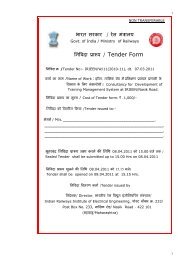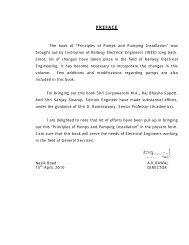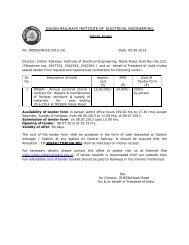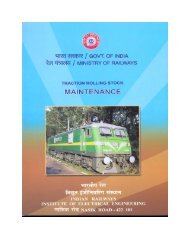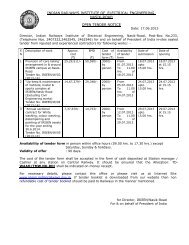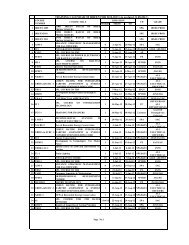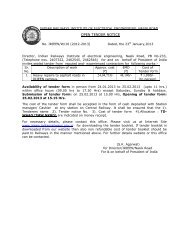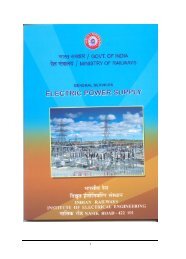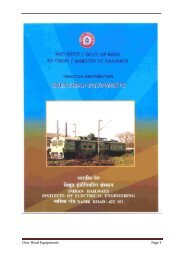remote control equipment - Indian Railways Institute of Electrical ...
remote control equipment - Indian Railways Institute of Electrical ...
remote control equipment - Indian Railways Institute of Electrical ...
You also want an ePaper? Increase the reach of your titles
YUMPU automatically turns print PDFs into web optimized ePapers that Google loves.
2.2 Oxidation<br />
Carbondioxide is the gas predominantly liberated during the process <strong>of</strong><br />
oxidation. The process begins when small quantities <strong>of</strong> oil combine<br />
chemically with the dissolved oxygen in the oil resulting in formation <strong>of</strong><br />
trace-5 <strong>of</strong> organic acids. These acids react with the metal <strong>of</strong> the<br />
transformer, forming metal based soaps which dissolve In the oil and<br />
act as a catalyst to accelerate the process <strong>of</strong> oxidation.<br />
2.3 Vapourisation<br />
The vapourisation <strong>of</strong> oil occurs at about 280° C while that for water<br />
occurs at about 100 °C. The false alarm <strong>of</strong> a Buchholz relay may be<br />
attributed to the fact that the condensation <strong>of</strong> water vapour takes place<br />
when the excess moisture in the tank is vapourized by a heat source.<br />
False alarm can also occur, when hydro-carbons, the constituents <strong>of</strong><br />
the insulating oil, vapourize.<br />
2.4 Insulation Decomposition<br />
The solid insulants in power transformers are mainly <strong>of</strong> cellulose or<br />
resinous type, viz.T paper, press board, resins and varnishes. These<br />
substances contain in their molecular structure substantial amounts <strong>of</strong><br />
oxygen, carton and hydrogen. In the temperature range <strong>of</strong> 150° C to<br />
400 o C, the insulation breakdown results in liberation <strong>of</strong> hydrogen,<br />
carbon dioxide and carbon monoxide. Above 400° C, the gases formed<br />
are relatively less.<br />
2.5 Oil Break Down<br />
The direct break down <strong>of</strong> oil by arcing results in cracking <strong>of</strong> the oil. The<br />
aromatic contents breakdown into simple and hydrogen. Acetylene and<br />
methane aie the major constituents Other hydro carbon gases may<br />
also be liberated due to cracking, if the necessary temperature is<br />
maintained for their stable formation.<br />
2.6 Electrolytic action<br />
Hydrogen and oxygen are liberated during electrolytic action. Presence<br />
<strong>of</strong> minute and small particles <strong>of</strong> fibres within the oil leads to electrolytic<br />
action. Light hydrocarbon gases may also be present, if solid insulation<br />
is involved.<br />
56




